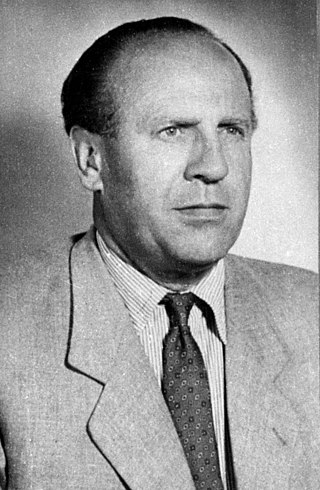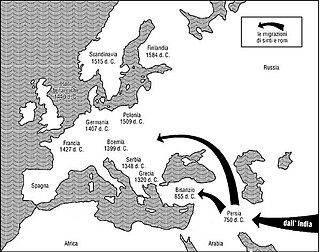
The Romani, also spelled Romany or Rromani, colloquially known as the Roma, are an Indo-Aryan ethnic group who traditionally lived a nomadic, itinerant lifestyle. Linguistic and genetic evidence suggests that the Romani originated in the Indian subcontinent; in particular, the region of present-day Rajasthan. Their subsequent westward migration, possibly in waves, is now believed by historians to have occurred around 1000 AD. Their original name is from the Sanskrit word डोम (doma) and means a member of a Dalit caste of travelling musicians and dancers. The Roma population moved west into the Persian Ghaznavid Empire and later into the Byzantine Empire. The Roma arrived in Europe around the 13th to 14th century. Although they are dispersed, their most concentrated populations are located in Bulgaria, Romania, Hungary, Turkey and Spain.

Oskar Schindler was a German industrialist, humanitarian and member of the Nazi Party who is credited with saving the lives of 1,200 Jews during the Holocaust by employing them in his enamelware and ammunitions factories in occupied Poland and the Protectorate of Bohemia and Moravia. He is the subject of the 1982 novel Schindler's Ark and its 1993 film adaptation, Schindler's List, which reflected his life as an opportunist initially motivated by profit who came to show extraordinary initiative, tenacity, courage, and dedication in saving his Jewish employees' lives.

The Romani Holocaust or the Romani genocide was the planned effort by Nazi Germany and its World War II allies and collaborators to commit ethnic cleansing and eventually genocide against European Roma and Sinti peoples during the Holocaust era.
Anti-Slavic sentiment, also known as Slavophobia, refers to various negative attitudes towards Slavic peoples, the most common manifestation being a claim that inhabitants of Slavic nations are inferior to other ethnic groups. Slavophobia reached its peak in Europe during World War II, when Nazi Germany declared Slavs, especially neighboring Poles to be subhuman (Untermensch) and planned to exterminate the majority of Slavic people. Slavophobia peaked twice in America- once during the Progressive Era immigration of the early 1900s, and again during the Cold War.

Emilie Schindler was a Sudeten German-born woman who, with her husband Oskar Schindler, helped to save the lives of 1,200 Jews during World War II by employing them in his enamelware and munitions factories, providing them immunity from the Nazis. She was recognized as Righteous Among the Nations by Israel's Yad Vashem in 1994.
Marek Jan Chodakiewicz is a Polish-American historian specializing in Central European history of the 19th and 20th centuries. He teaches at the Patrick Henry College and at the Institute of World Politics. He has been described as conservative and nationalistic, and his attitude towards minorities has been widely criticized.

The Schindlerjuden, literally translated from German as "Schindler Jews", were a group of roughly 1,200 Jews saved by Oskar Schindler during the Holocaust. They survived the years of the Nazi regime primarily through the intervention of Schindler, who afforded them protected status as industrial workers at his enamelware factory in Kraków, capital of the General Government, and after 1944, in an armaments factory in occupied Czechoslovakia. There, they avoided being sent to death camps and survived the war. Schindler expended his personal fortune made as an industrialist to save the Schindlerjuden.

The Nuremberg Laws were antisemitic and racist laws that were enacted in Nazi Germany on 15 September 1935, at a special meeting of the Reichstag convened during the annual Nuremberg Rally of the Nazi Party. The two laws were the Law for the Protection of German Blood and German Honour, which forbade marriages and extramarital intercourse between Jews and Germans and the employment of German females under 45 in Jewish households; and the Reich Citizenship Law, which declared that only those of German or related blood were eligible to be Reich citizens. The remainder were classed as state subjects without any citizenship rights. A supplementary decree outlining the definition of who was Jewish was passed on 14 November, and the Reich Citizenship Law officially came into force on that date. The laws were expanded on 26 November 1935 to include Romani and Black people. This supplementary decree defined Romanis as "enemies of the race-based state", the same category as Jews.

Untermensch is a German language word literally meaning 'underman', 'sub-man', or 'subhuman', that was extensively used by Germany's Nazi Party to refer to non-Aryan people they deemed as inferior. It was mainly used against "the masses from the East", that is Jews, Roma, and Slavs.

Robert Ritter was a German racial scientist doctor of psychology and medicine, with a background in child psychiatry and the biology of criminality. In 1936, Ritter was appointed head of the Racial Hygiene and Demographic Biology Research Unit of Nazi Germany's Criminal Police, to establish the genealogical histories of the German "Gypsies", both Roma and Sinti, and became the "architect of the experiments Roma and Sinti were subjected to." His pseudo-scientific "research" in classifying these populations of Germany aided the Nazi government in their systematic persecution toward a goal of "racial purity".
Robin O'Neil is a Holocaust researcher and author. After a career as the British major crimes' investigator who worked on criminal investigations for Scotland Yard, the Metropolitan Police Service, and London Home Counties Police, he obtained his Masters and Doctorate with the Hebrew and Jewish Department at University College London. He now specialises in researching Nazi war crimes and the destruction of the European Jewish communities (1933–1945).
The Romani people, also referred to as Roma, Sinti, or Kale, depending on the subgroup, are an Indo-Aryan ethnic group that primarily lives in Europe. The Romani may have migrated from what is the modern Indian state of Rajasthan, migrating to the northwest around 250 BC. Their subsequent westward migration, possibly in waves, is now believed to have occurred beginning in about 500 AD. It has also been suggested that emigration from India may have taken place in the context of the raids by Mahmud of Ghazni. As these soldiers were defeated, they were moved west with their families into the Byzantine Empire.

The Romani people are a distinct ethnic and cultural group of peoples living all across the globe, who share a family of languages and sometimes a traditional nomadic mode of life. Though their exact origins are unclear, central India is a notable point of origin. Their language shares a common origin with, and is similar to, modern-day Gujarati and Rajasthani, borrowing loan words from other languages as they migrated from India. In Europe, even though their culture has been victimized by other cultures, they have still found a way to maintain their heritage and society. Indian elements in Romani culture are almost non-existent, with the exception of their language. Romani culture focuses heavily on family. The Roma traditionally live according to relatively strict moral codes. The ethnic culture of the Romani people who live in central, eastern and southeastern European countries developed through a long, complex process of continuous active interaction with the culture of their surrounding European population.

Anti-Romani sentiment is a form of bigotry which consists of hostility, prejudice, discrimination, racism and xenophobia which is specifically directed at Romani people. Non-Romani itinerant groups in Europe such as the Yenish, Irish and Highland Travellers are frequently given the name "gypsy" and as a result, they are frequently confused with the Romani people. As a result, sentiments which were originally directed at the Romani people are also directed at other traveler groups and they are frequently referred to as "antigypsy" sentiments.

Amon Leopold Göth was an Austrian SS functionary and war criminal. He served as the commandant of the Kraków-Płaszów concentration camp in Płaszów in German-occupied Poland for most of the camp's existence during World War II.

Romani Americans are Americans who have full or partial Romani ancestry. It is estimated that there are one million Romani people in the United States. Though the Romani population in the United States has largely assimilated into American society, the largest concentrations are in Southern California, the Pacific Northwest, Southwestern United States, Texas, Louisiana, Florida and the Northeast as well as in cities such as Chicago and St. Louis.
Leon Leyson was a Polish-American Holocaust survivor and one of the youngest Schindlerjuden, Jews saved by Oskar Schindler. His posthumously published memoir, The Boy on the Wooden Box: How the Impossible Became Possible. .. on Schindler's List details his survival during the Holocaust.

The Romani people, also known as the Roma, qualify as an ethnic minority group in Poland of Indo-Aryan origins. The Council of Europe regards the endonym "Roma" more appropriate when referencing the people, and "Romani" when referencing cultural characteristics. The term Cyganie is considered an exonym in Poland.
Symcha Spira, also known as Symche Spira, served as the head of the Krakow ghetto Jewish police during the Holocaust.
This is a select bibliography of English language books and journal articles about the history of Belarus and Byelorussia. A brief selection of English translations of primary sources is included. Book entries have references to journal articles and reviews about them when helpful. Additional bibliographies can be found in many of the book-length works listed below; see Further Reading for several book and chapter-length bibliographies. The External links section contains entries for publicly available select bibliographies from universities.













